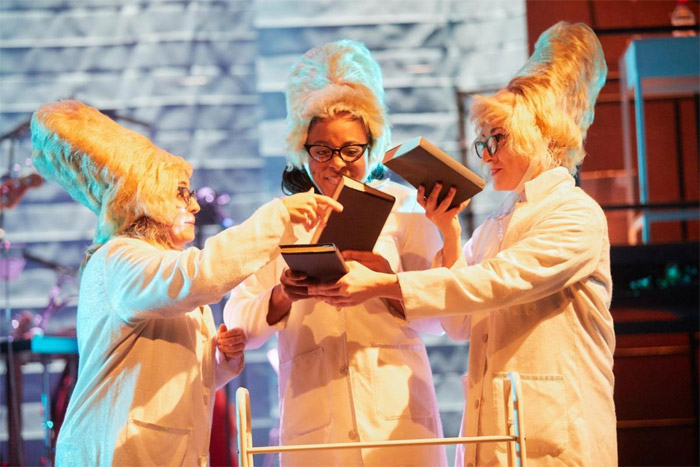Presented by Complicite Associates, Bryony Kimmings Ltd & National Theatre
Directed by Kirsty Housley
Written by Bryony Kimmings and Brian Label with Kirsty Housley
Music by Tom Parkinson
Originally a co-production with the National Theatre in association with HOME Manchester
Liverpool Playhouse
29th January – 3rd February 2018
Reviewed by Rob Harrison
Photograph by Mark Douet
Cancer is the eternal bogeyman or bogey woman. We have managed to put a man on the moon, split the atom and have the power to destroy entire continents, but are still not any nearer to a cure. I find that strange.
Cancer is such an emotive subject, as to bear witness to Facebook reactions to a recent review of the this show a few nights ago.
A Pacifists Guide To Cancer seeks to define what it is and what it means to sufferers and their immediate family and friends.
Bryony Kimmings decides to poke around in the kingdom of the sick, to quote the author Susan Sontag, who wrote a novel about her experience with the illness. She says of it that we walk between the worlds of those who are well and the ones who are ill.
It can be, as Kimmings points out, comparable to the stage area where the divisions are clearly visible – two worlds in one.
The show begins with Kimmings trying desperately to pitch ideas to get a show funded. She throws ideas around but most of them are rejected, until she hits on an idea about cancer. The agent then confides in her that she is undergoing chemotherapy treatment, and thinks, well ok, let’s do a show about cancer.
So in a nutshell the Pacifist’s Guide is a musical about the big C with an autobiographical storyline. It tells of Kimmings journey through the land of the sick using the language of feminist authors, patients and artists stricken with the disease.
Such artists as photographer Jo Spence, who was diagnosed with breast cancer by a male doctor. He drew an x on her breast and casually pronounced “This has to come off”. Spence was incensed, feeling dehumanized by the situation, and felt she had become just like a piece of meat.
So as a way of making sense of her trauma she decided to document her illness and life through photography, as a means of alternative communication rather than the written word.
Apart from the obvious dark subject matter this is an engrossing and entertaining show, and the ensemble cast revolve around playing the tunes and acting.
The songs, written by Tom Parkinson, are really good and the set is visually stunning with brilliant emotive lighting effects.
Towards the end of the show Kimmings pulls down a giant curtain at the back of the stage, with the word cancer written on it, to reveal a giant forest, with one of the cast wrapped up in vines trying to escape, letting us witness a slightly surrealist take on being overcome by the disease.
This is one of the strengths of the show, which mixes slight surrealist imagery with dark almost expressionist sets. When the curtain is pulled down it’s done in a highly dramatic, one could say old fashioned theatrical, way, reminding me of the final scene in Dracula, where Van Helsing runs across the table and pulls down the giant curtains to reveal the sunlight to destroy the count. Metaphor anyone, blood /draining etc?
As the show draws to a close members of the audience are invited to tell their own cancer tales. It then starts to bring it home to you as the audience members rise up one by one and bear witness to cancer, whether it be sufferer, relative or friend.
So it’s not just a play folks, an interesting device to finish the show indeed.
Verdict: recommended
